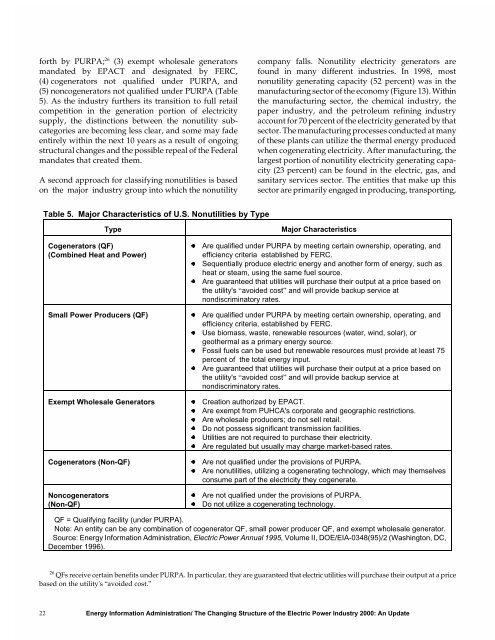The Changing Structure of the Electric Power Industry 2000: An ... - EIA
The Changing Structure of the Electric Power Industry 2000: An ... - EIA
The Changing Structure of the Electric Power Industry 2000: An ... - EIA
Create successful ePaper yourself
Turn your PDF publications into a flip-book with our unique Google optimized e-Paper software.
forth by PURPA; 26 (3) exempt wholesale generators<br />
mandated by EPACT and designated by FERC,<br />
(4) cogenerators not qualified under PURPA, and<br />
(5) noncogenerators not qualified under PURPA (Table<br />
5). As <strong>the</strong> industry fur<strong>the</strong>rs its transition to full retail<br />
competition in <strong>the</strong> generation portion <strong>of</strong> electricity<br />
supply, <strong>the</strong> distinctions between <strong>the</strong> nonutility subcategories<br />
are becoming less clear, and some may fade<br />
entirely within <strong>the</strong> next 10 years as a result <strong>of</strong> ongoing<br />
structural changes and <strong>the</strong> possible repeal <strong>of</strong> <strong>the</strong> Federal<br />
mandates that created <strong>the</strong>m.<br />
A second approach for classifying nonutilities is based<br />
on <strong>the</strong> major industry group into which <strong>the</strong> nonutility<br />
26<br />
QFs receive certain benefits under PURPA. In particular, <strong>the</strong>y are guaranteed that electric utilities will purchase <strong>the</strong>ir output at a price<br />
based on <strong>the</strong> utility's “avoided cost.”<br />
22<br />
Table 5. Major Characteristics <strong>of</strong> U.S. Nonutilities by Type<br />
Cogenerators (QF)<br />
(Combined Heat and <strong>Power</strong>)<br />
Type Major Characteristics<br />
� Are qualified under PURPA by meeting certain ownership, operating, and<br />
efficiency criteria established by FERC.<br />
� Sequentially produce electric energy and ano<strong>the</strong>r form <strong>of</strong> energy, such as<br />
heat or steam, using <strong>the</strong> same fuel source.<br />
� Are guaranteed that utilities will purchase <strong>the</strong>ir output at a price based on<br />
<strong>the</strong> utility's “avoided cost” and will provide backup service at<br />
nondiscriminatory rates.<br />
Small <strong>Power</strong> Producers (QF) � Are qualified under PURPA by meeting certain ownership, operating, and<br />
efficiency criteria, established by FERC.<br />
� Use biomass, waste, renewable resources (water, wind, solar), or<br />
geo<strong>the</strong>rmal as a primary energy source.<br />
� Fossil fuels can be used but renewable resources must provide at least 75<br />
percent <strong>of</strong> <strong>the</strong> total energy input.<br />
� Are guaranteed that utilities will purchase <strong>the</strong>ir output at a price based on<br />
<strong>the</strong> utility's “avoided cost” and will provide backup service at<br />
nondiscriminatory rates.<br />
Exempt Wholesale Generators � Creation authorized by EPACT.<br />
� Are exempt from PUHCA's corporate and geographic restrictions.<br />
� Are wholesale producers; do not sell retail.<br />
� Do not possess significant transmission facilities.<br />
� Utilities are not required to purchase <strong>the</strong>ir electricity.<br />
� Are regulated but usually may charge market-based rates.<br />
Cogenerators (Non-QF) � Are not qualified under <strong>the</strong> provisions <strong>of</strong> PURPA.<br />
� Are nonutilities, utilizing a cogenerating technology, which may <strong>the</strong>mselves<br />
consume part <strong>of</strong> <strong>the</strong> electricity <strong>the</strong>y cogenerate.<br />
Noncogenerators<br />
(Non-QF)<br />
company falls. Nonutility electricity generators are<br />
found in many different industries. In 1998, most<br />
nonutility generating capacity (52 percent) was in <strong>the</strong><br />
manufacturing sector <strong>of</strong> <strong>the</strong> economy (Figure 13). Within<br />
<strong>the</strong> manufacturing sector, <strong>the</strong> chemical industry, <strong>the</strong><br />
paper industry, and <strong>the</strong> petroleum refining industry<br />
account for 70 percent <strong>of</strong> <strong>the</strong> electricity generated by that<br />
sector. <strong>The</strong> manufacturing processes conducted at many<br />
<strong>of</strong> <strong>the</strong>se plants can utilize <strong>the</strong> <strong>the</strong>rmal energy produced<br />
when cogenerating electricity. After manufacturing, <strong>the</strong><br />
largest portion <strong>of</strong> nonutility electricity generating capacity<br />
(23 percent) can be found in <strong>the</strong> electric, gas, and<br />
sanitary services sector. <strong>The</strong> entities that make up this<br />
sector are primarily engaged in producing, transporting,<br />
� Are not qualified under <strong>the</strong> provisions <strong>of</strong> PURPA.<br />
� Do not utilize a cogenerating technology.<br />
QF = Qualifying facility (under PURPA).<br />
Note: <strong>An</strong> entity can be any combination <strong>of</strong> cogenerator QF, small power producer QF, and exempt wholesale generator.<br />
Source: Energy Information Administration, <strong>Electric</strong> <strong>Power</strong> <strong>An</strong>nual 1995, Volume II, DOE/<strong>EIA</strong>-0348(95)/2 (Washington, DC,<br />
December 1996).<br />
Energy Information Administration/ <strong>The</strong> <strong>Changing</strong> <strong>Structure</strong> <strong>of</strong> <strong>the</strong> <strong>Electric</strong> <strong>Power</strong> <strong>Industry</strong> <strong>2000</strong>: <strong>An</strong> Update

















